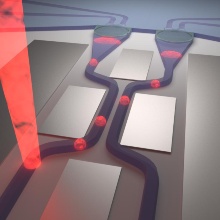Fully integrated quantum photonic circuits show a clear advantage in terms of stability and scalability compared to tabletop implementations. They will constitute a fundamental breakthrough in integrated quantum technologies, as a matter of example, in quantum simulation and quantum computation. Despite the fact that only a few building blocks are strictly necessary, their simultaneous realization is highly challenging. This is especially true for the simultaneous implementation of all three key components on the same chip: single-photon sources, photonic logic, and single-photon detectors. Here, we present a fully integrated Hanbury-Brown and Twiss setup on a micrometer-sized footprint consisting of a GaAs waveguide embedding quantum dots as single-photon sources, a waveguide beamsplitter, and two superconducting nanowire single-photon detectors. This enables a second-order correlation measurement on the single-photon level under both continuous-wave and pulsed resonant excitation. The presented proof-of-principle experiment proves the simultaneous realization and operation of all three key building blocks and therefore a major step towards fully integrated quantum optical chips.
Publication:Fully On-Chip Single-Photon Hanbury-Brown and Twiss Experiment on a Monolithic Semiconductor–Superconductor Platform
Mario Schwartz, Ekkehart Schmidt, Ulrich Rengstl, Florian Hornung, Stefan Hepp, Simone L. Portalupi, Konstantin llin, Michael Jetter, Michael Siegel, and Peter Michler ![]() Nano Lett. 2018, 18, 11, 6892-6897
Nano Lett. 2018, 18, 11, 6892-6897
Press releases:
Contact person: M. Schwartz


